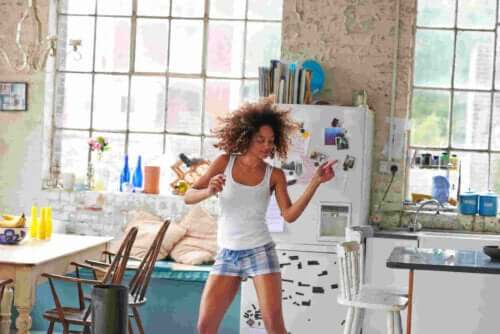Dance therapy is gaining attention because it combines physical exercise with dance. Discover 5 reasons to practice this activity, as well as some tips.
In pursuit of a fun and healthy lifestyle, Dance therapy has gained popularity as an exercise option that combines rhythmic movement with music. This discipline, also known as “fitness dance”, offers a unique experience that goes beyond improving physical performance.
In this article, we’ll explore the top five benefits of dance therapy and ways to incorporate it into the comfort of your daily life. From weight loss to strengthening personal relationships, we’ll discover how this form of physical activity can improve your overall well-being.
Dance therapy, between physical exercise and the art of dance
The origin of dance therapy is in Europe. From there, it spread to different continents, especially to Latin America. This unique and versatile discipline is not limited to a single musical genre, but encompasses a wide variety of rhythms, from merengue, salsa and reggaeton to hip hop.
According to Blanca Libia Monsalve, a graduate in physical culture, during a séance In dance therapy, a series of exercises are performed to activate different parts of the body and increase cardiovascular resistance. Some of the common exercises include the options mentioned below.
Marche
A basic form of exercise in dance therapy. Walking involves marching in place to the beat of music. This helps increase our heart rate and improve our cardiovascular endurance.
Not crossed
In this movement, the feet cross while moving forward or backward. It is an activity related to strengthening leg muscles and greater stability.
V-Shaped Exercise
It consists of opening and closing the legs in a pattern similar to the letter “V”. This exercise works the muscles of the legs and buttocks, improving coordination and strength.
Jogging
This is a common aerobic activity in dance therapy. It involves lifting your knees while running in place to the rhythm of the music. It helps increase heart rate, burn calories and to strengthen the cardiovascular system.
Jumping Jack
This classic jumping move is perfect for increasing the intensity of your dance therapy routine. It starts with your feet together. Then you jump by opening your legs and raising your arms at the same time. Then return to the starting position.
THE jumping Jack improve endurance, work the body’s muscles and stimulate calorie burning.
The 5 benefits of dance therapy
According to a article published in the journal “Lecturas: Educación Física y Deportes”, dance therapy is a practice that offers a wide range of benefits for general well-being. In addition to being a fun way to exercise, It has a positive impact on various vital systems of the human body.
1. Weight loss
In this research, Alina Acanda and Aleida Best mention that it is possible to burn between 500 and 1000 calories, depending on the metabolism of each one. This activity combines dance movements with aerobic exercises. Which contributes to burning fat effectively.
2. Improved lung capacity
Dance therapy involves rhythmic and coordinated movements that require deep, controlled breathing. When you engage in this practice, your lungs are challenged to work harder, resulting in improved lung capacity.
In fact, a research published in the highlights that this is a recommended activity for people with chronic obstructive pulmonary disease (COPD).
3. Benefits of dance therapy: Improved cardiovascular health
While dancing, the heart rate increases and leads to better blood circulation. This, in turn, helps to strengthen the heart and improve cardiovascular endurance. So dance therapy is a fun way to exercise and keep your heart healthy.
4. Improvement of the central nervous system
Dancing is an activity that engages both the body and the mind. Which has a positive impact on the central nervous system. By moving to the rhythm of the music and making coordinated movements, the release of endorphins, neurotransmitters responsible for generating feelings of well-being, is stimulated.
On the other hand, dance therapy helps improve coordination and balance. Because she stimulates neural connections and promotes greater mental agility.
5. Benefits of dance therapy: Strengthening personal relationships
Dance therapy not only benefits the body, but also personal relationships. Participating in classes or group sessions allows you to interact with others who share the same interest in dance and exercise. This creates a socially enriching environment, where enjoyment, mutual support and motivation are encouraged.
How to practice dance therapy at home?
Dance therapy is suitable for people of all ages and fitness levels. No previous dance experience or special skills are required to begin practicing it. Children, youth and adults can benefit from this practice and adapt it to their individual needs and abilities.
We share the basic steps so you can enjoy the benefits of this activity. Adding variety and fun to your home exercise routine:
- Find a suitable space.
- Choosing our favorite music, try to have a pronounced rhythm.
- Warm-up. This may include stretching exercises, light jumping, or low-impact aerobic movements to increase your body temperature and prepare your muscles.
- Follow the online tutorials.
- Create our own routine. Combine different dance steps and movements to the rhythm of the selected music. Don’t be afraid to be creative and add our own style.
- Inviting friends or family over, dancing together can be even more fun.
- Set goals and stay consistent.
Dance therapy, a fun activity to keep fit
Including physical activity in the daily routine is crucial to maintain optimal physical and mental health. Dance therapy has become a very attractive option. Because it is varied, fun and suitable for all ages.
Finally, the most interesting thing is that it can be practiced both in specialized places and at home. It is enough to dedicate between 20 and 30 minutes to obtain its interesting benefits.




